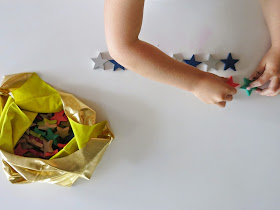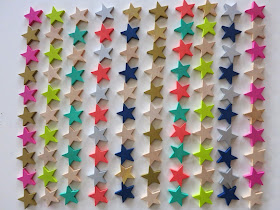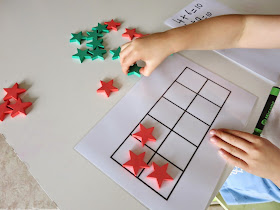Follow us for fun activities and ideas on Pinterest
This is a sponsored post
When Krystal from Sweet Elephants contacted me to have a look through her online store and see if there was anything that inspired me, it didn't take me long to find something. Whilst the store was full of unique and good quality toys and gifts for children, when I saw the Tanabata Star Dominos, I instantly fell in love. This seemingly simple manipulative for children looked to be beautifully made and the bright, bold, colours in different tones to most children's toys, leapt out at me. We love using loose parts for play and learning so I knew that my children would love and get a lot of use out of the Tanabata Stars.
When the stars arrived, we were not disappointed. They are beautiful. There were gasps when we opened them and we were drawn to get them out. You may want to start just by mixing those beautiful colours together like we did, or perhaps you would prefer to get them out and stack them according to colour. Whatever you do, there is sure to be a great deal of play and learning ahead that includes these stars. See the bottom for your chance to win a set.
There are 100 stars in the set in total. 7 different coloured groups of 10 stars and 30 plain wooden stars with numbers 0-9 printed on one side. (3 copies of each number) This definitely makes this set a fabulous teaching resource.
Counting and ordering

Patterns and Designs
Pretend play and exploration
Hint: If using wooden materials with playdough, I recommend using a homemade playdough version to prevent staining. My kids unfortunately used a bit of store-bought playdough and some of the colour lightly stained some of the wood.Informal Measuring

Sorting and grouping
Building
Learning
"Invitation to Make 10"
Learning and understanding the combination of numbers that make up to 10 is important for children. The skill to "make to ten" helps children to understand our Decimal System (Base 10) and aids with mental addition, subtraction and further mathematical concepts down the track. Using some coloured counters/loose-parts along with a tens frame will help children to physically manipulate the materials and see for themselves the combinations that make 10. The more they experience and practice this, the better their understanding.
Materials:
- 2 groups of different coloured counters. 10 of each (we used our Tanabata stars)
- Tens frame (download and print your own tens frame here) I laminated ours for extra durability.
- Paper/marker for recording combinations
Directions:
- Encourage children to count out and place 10 counters/stars in the tens frame ensuring that there is only one counter per space.
- How many different number combinations can they come up with using the 2 colours?
- Record your discoveries
- For added difficulty, add in extra colours
- To simplify, record the answers for your child or use wooden numbers to show your results. Younger children can enjoy and practice simply counting up to ten and the one-to-one correspondence of putting one counter in each space.
One of the most joyful things about children playing and discovering in a hands-on, playful manner, is watching the joy, excitement and pride they display, when they achieve, learn and make their own connections and understandings.
Here are a couple of others ways that we have played "making 10."
"Memory Make 10 Game"
Materials:
- Tanabata stars/counters/bottle tops etc. 2 of each number 1-9 (on counters/bottle tops etc. you can add your own numbers).
To Play:
- Mix the numbers around and place them face down in rows
- Take turns to turn over 2 game pieces. Instead of looking for matching pairs, you are looking for 2 numbers that together make 10. (ie. 6 & 4, 2 & 8, etc.)
- The person with the most pairs at the end is the winner.
When children turn over one number, talk about that number and ask "which number do you need to find to make ten?" (ie. Maddie turned over a 2 first. She figured out that she needed to find an 8 in order to make a pair). You can provide extra counters/manipulatives for children to count to assist them in figuring out the combinations that make ten or for adding the two numbers together.
Thinking...thinking....
She beat me! (and I didn't let her win).
As you can see, we have had a fabulous time so far playing and learning with our Tanabata Stars. They are a gorgeous addition to our loose parts play and would make a special and unique gift.
To purchase your own set, head here and to browse the rest of the Sweet Elephants store, see here.
TANABATA STARS GIVEAWAY
* This giveaway has ended. The winner will be contacted shortly.Thanks to Sweet Elephants, just in time for Christmas, we have a set of the Kiko Tanabata Stars to give away to one of our Aussie readers. As Christmas is all about giving, to enter, pop over to the online gift store and leave us a comment here answering the question,
"Which gift would you give to someone and why?"
Terms and Conditions: This competition has ended.
Giveaway is for one set of the Kiko Tanabata Stars RRP $59.99 including delivery within Australia
Australia Entries only.
Must leave a name and email address if using "anonymous" or a profile not linked to a way to contact you if you've won.
Winner will be deemed most creative/interesting response as chosen by us. This is a game of skill, not chance.
Entries open 12.01am Tuesday 4th Nov and close Monday 10th Nov 11.59pm. Judges decision is final. Winner must respond within 48 hours or prize will be awarded to the runner up. Good luck.
Happy playing,
Debs :)
{Disclosure: this is a sponsored post for Sweet Elephants. We happily excepted a voucher to the online shop in lieu of payment. As always, opinions expressed in this post are my own and my children's.}
{Disclosure: this is a sponsored post for Sweet Elephants. We happily excepted a voucher to the online shop in lieu of payment. As always, opinions expressed in this post are my own and my children's.}
Look where else we are. Are you following along? :)
New Here? Subscribe to get all activities sent directly to you









































